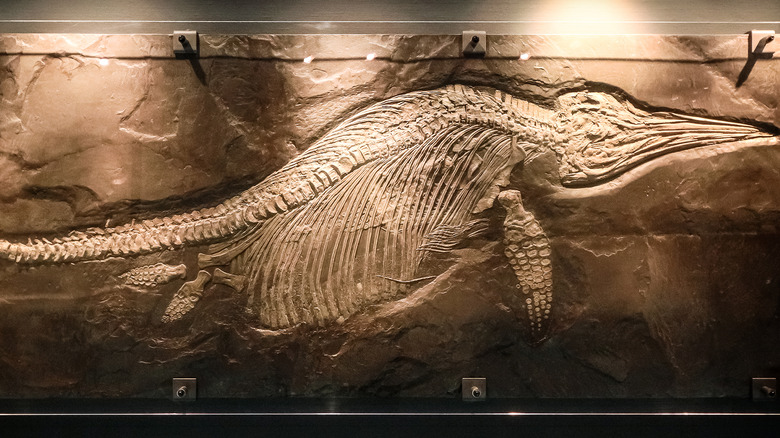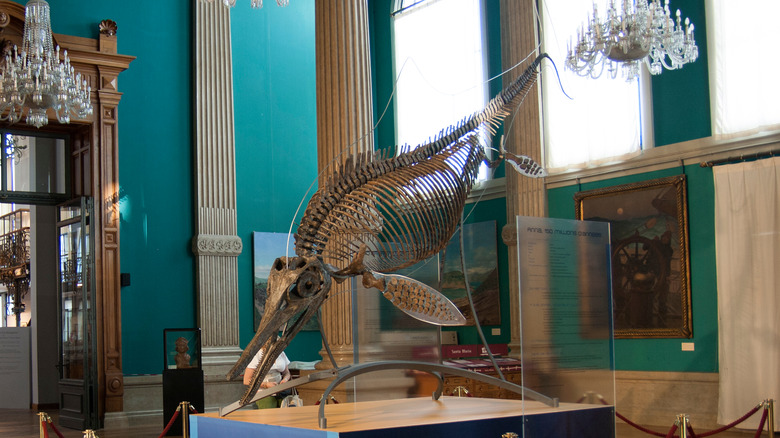How A Rare Fossil Lost In World War II Was Found
May 11, 1941, holds a dark place in British history. It was on this day during WWII that Nazi Germany conducted the biggest raid of Blitzkrieg, which loosely translates to "the lightning war" (via IWM). British civilians watched in horror as 711 tons of explosive artillery fell from the sky, sending shockwave blasts that would claim the lives of 1,436 people in a single day.
National Geographic reports that during the aerial attacks, approximately 1.7 million buildings were damaged and more than 70,000 were utterly destroyed. One of those buildings was the Royal College of Surgeons of England, which housed an impressive collection of ancient books and artifacts, many of which had been temporarily removed in anticipation of the destruction. When the bombs exploded, much of the historic landmark was ravaged, including one rather odd artifact — a rare fossil of the infamous ichthyosaur, a distinct aquatic reptile that was around during the Jurassic and Triassic periods, 251 million years in the past (per Britannica).
According to All That Is Interesting, The Royal College of Surgeons was home to the first fully complete fossil of the extinct ocean-dwelling species. The specimen was presumably lost forever, gone in the wisps of smoke and ash. Until now...
Casts of the lost creature were discovered in museum basements
As it turns out, digging for fossils isn't always relegated to the hidden layers of the earth. Indeed, some of the best historical relics are unarchived objects unearthed in the basements of historical museums. Or at least that's how this story goes, according to All That Is Interesting.
According to The New York Times, paleontologist Dean Lomax has referred to ichthyosaurs as "the real icons of evolution" in terms of the way they were studied and preserved. The original London-based skeleton, widely presumed to be the work of pioneering fossil hunter Mary Anning, was a groundbreaking discovery that opened up the field of evolutionary science. The scientific community incurred a collective loss when the fossil was blown to bits.
In a rather bizarre twist, Lomax and his colleague Judy Massare of the State University of New York encountered an overlooked cast of the forgotten fossil in Yale University's Peabody Museum. This finding became part of a large study published by The Royal Society which aimed to uncover the hidden history of the first complete ichthyosaur skeleton by uncovering abandoned casts of the original. Much to the researchers' surprise, the Peabody Museum didn't house the only copy of the first completed fossil.
The Natural History Museum in Berlin, Germany currently holds the most complete cast
In the Royal Society's Open Science study, researchers declared, "We have discovered two plaster casts of the specimen, although no record exists of casts ever being made."
This find opens up a whole host of historical possibilities, from the opportunity to compare and contrast the casts with scientific illustrations of the original fossil to the possibility that even more unarchived casts exist around the world. Ironically, the fossil that was lost to bombs delivered by German forces is now best preserved in the Berlin-based Natural History Museum where the second cast was found (via The New York Times).
According to All That Is Interesting, this second cast contains immaculate detailing made possible by modern, modified techniques. Using the cast as a point of reference, researchers have already found several discrepancies between the original fossil and the 1819 illustration of it. Namely, the femur appears slimmer and more symmetrical in the drawing than it does in the cast, and there are several small bones shown in the picture that could not be found when analyzing the newly-discovered fossil copies.
Perhaps the most exciting aspect of this discovery, however, is the underlying sense of possibilities. Who knows what other unaccounted-for objects might exist beneath the dust of a forgotten museum shelf?


